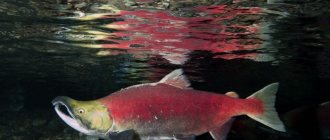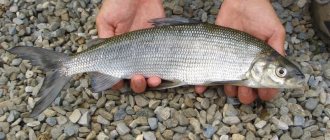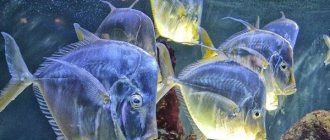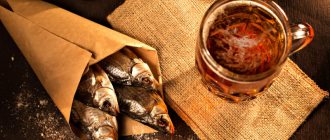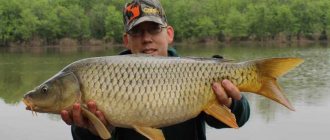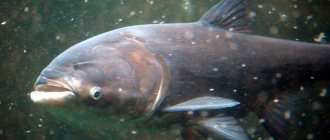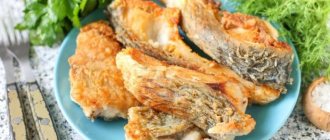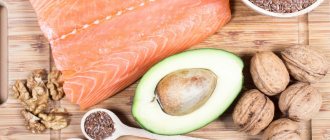Chum salmon belongs to the salmon family and is its most common representative. Chum salmon prefers salty sea water. The habitat of this type of fish is the North Pacific Ocean, the Bering and Okhotsk seas, and the coast of North America.
Chum salmon fish is the most important object of the fishing industry; its delicate dietary meat has an excellent taste, and red caviar is the largest of all types of caviar of the salmon family. In sea waters, the fish has an even silvery color; when entering the river (to spawn), the color darkens, while the meat has a delicate pink-red color.
What does chum salmon look like and where is it found?
Chum salmon is a marine species, so it has the usual coloring for such inhabitants. The body of the fish has silvery scales, sometimes with a blue tint or tint.
On the back they are a little darker and brighter, on the stomach they are lighter. This allows the representative of the salmon family to camouflage well from enemies and remain unnoticed while hunting for prey. Let us note the main features of chum salmon:
- elongated, slightly elongated, rather massive body;
- laterally tucked, pressed torso;
- the presence of feathers on the fins, shifted towards the tail;
- absence of dark spots in the mouth and stripes;
- wide jaw with underdeveloped teeth;
- large cone-shaped head;
- medium-sized scales on the body;
- large tail with a solid fin without a notch.
During the spawning period, chum salmon completely changes its appearance. The body becomes denser, expands, and increases in size. A hump forms on the dorsal part of the body. The jaws and even the teeth become larger, lengthening and bending slightly.
During spawning, the fish completely changes its color. Instead of a silver fish, you can see a brown, green, yellow or even olive representative of salmon. There are crimson or purple stripes on its sides, but these darken over time.
Some individuals reach large sizes, the length of which reaches 80 cm, and the weight can exceed the bar of 10 kg. According to official information, the maximum size of chum salmon is 1.5 m, weight – 16 kg. But it is rare to catch such a fish. Typically, fish coming out to spawn are no more than 60 cm in length. It is worth noting that in summer its size is smaller than in winter.
What does chum salmon eat?
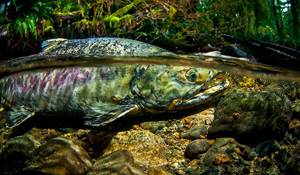
Photo: Chum salmon fish
As the fish grows, the lifestyle of the fish changes. When it reaches the optimal size and body weight at which it is relatively safe to exist in the open sea, it begins to lead a predatory lifestyle. During the period of gaining body weight, the fish needs a large amount of food, which can only be found in the sea.
After the fry grow up, they begin to gradually slide into the open sea. There they gather in groups and find quiet, secluded places in which they hide until they reach optimal size.
With age, the fish switches to a predatory lifestyle and eats larger prey. During this period, a large amount of prey is required to ensure that daily weight gain and growth meet the norms.
Food supply for adults:
- gerbil;
- herring;
- smelt;
- small flounder;
- anchovies;
- squid;
- sardines;
- bulls.
Due to the fact that fish live in a school, they also hunt in schools. The specific coloring helps them not only remain unnoticed by enemies, but also by their prey. Often it is enough for a fish to simply freeze, waiting for its prey. When potential food approaches as close as possible, the fish makes a lunge and grabs the prey. Sometimes a school of chum salmon simply crashes into a school of other fish and simply grabs everyone who did not have time to escape.
Chum salmon biology
Characteristic
An anadromous fish, it spends most of its life in the sea and breeds exclusively in rivers. It spawns once in its life and dies after spawning.
Spawning
Occurs on small-pebble rocky soil, in springs, mostly non-freezing, in fast rivers and channels where there are outlets of groundwater - at a flow speed of 0.1-0.3 m/sec. and water temperature from 4 to 14°. Summer chum salmon spawn early and in the lower sections of rivers, autumn chum salmon spawn later and rise higher along rivers.
The spawning grounds of summer chum are located in the tributaries of the Amur (pp. Gorin, Amgun with their tributaries). In recent years, the spawning grounds of summer chum salmon have shifted lower along the Amur. The spawning grounds of autumn chum salmon are located in areas above the city of Khabarovsk, to the river. Bidzhan inclusive and, in particular, in the tributaries of the Ussuri: Khora, Bikin and Iman.
In Kamchatka, spawning grounds are located in fast mountain rivers. Spawning time for summer chum salmon is from August to the twentieth of September; The height of spawning on the Amur is in August, when the water temperature at the river mouths is about 12°, and at the spawning grounds 6-7°. In Kamchatka, the peak of spawning is later.
The spawning season of autumn chum salmon is from mid-September to the end of October (in Japan to November), the height is in October, when the water temperature in the rivers drops to 0° (the beginning of freezing), and in the springs - to 2-4°.

The depth of water at the spawning sites is from 10 to 100 cm, less often up to 4 m. When starting to spawn, the fish clears the bottom at the spawning site from silt or grass with blows of its tail.
The eggs are released into holes (nests) 30-40 cm deep knocked out by fish in sand or pebbles, after which they are covered with a layer of gravel. The depth of laying eggs ranges from 20 to 30-35 cm and even (rarely) up to 40 cm. The female usually lays three such nests, after which she places a gravel mound over them up to 2-3 m long and 1.5-2 m wide.
All this lasts from two to four, less often up to seven days. Having completed spawning, the female guards the nest for several (up to 14) days, after which she dies from exhaustion; males also die.
The fertility of summer chum salmon is 1.3-4.8 thousand eggs, on average 2.4-2.6 thousand, autumn chum salmon - 3.2-4.3 thousand eggs, on average 3.7 thousand.
Useful properties of chum salmon

Meat composition
Chum salmon meat contains a large amount of protein and is considered a dietary product of special value. Fish meat consists of 75% water, 20% protein, and 5% ash and fat. There are no carbohydrates in its meat, which makes its meat especially valuable.
KETA BENEFITS AND HARMS | chum salmon benefits and harms, chum salmon beneficial properties, all about chum salmon
Vitamins and microelements

Chum fish meat contains vitamins such as PP, E, C, B1, B2 and vitamin A. In addition, the meat is rich in micro- and macroelements. The presence of fatty acids such as omega-3 and omega-6, as well as lecithin, helps in the fight against atherosclerosis.
The presence of thiamine (vitamin B1) helps activate the cerebral cortex and improves memory. Vitamin B1 has a beneficial effect on the functioning of brain cells, which leads to improved perception of any information, and also increases mental abilities. In other words, thiamine fully ensures the normal functioning of the nervous system. Vitamin B is an excellent antioxidant that helps detoxify the human body. The presence of vitamin A improves vision and promotes collagen production. Vitamin E has a beneficial effect on the skin and is an antitoxic drug for the human body.
Potassium and magnesium, which fish contains in sufficient quantities, contribute to the normal functioning of the heart muscle. And the presence of potassium and phosphorus helps maintain a certain amount of calcium in the body.
Calorie content of chum salmon meat

100 grams of fish meat contains 125 kilocalories, but 100 grams of caviar contains 250 kilocalories.
Contraindications
As a rule, no one is prohibited from eating fish meat, especially chum salmon. An obstacle may be personal intolerance to this product. When consuming, you should always remember that chum salmon can be infected with parasites, so the meat can only be eaten after careful heat treatment. Alternatively, chum salmon can be frozen at a low temperature and kept there for one day.
What color should chum salmon meat be?
The color of chum salmon meat should be red with a pinkish tint. It may change as a result of spawning to a pale pink color. This happens because the pigment that is responsible for the color of the muscles begins to mobilize in the caviar and skin of the fish.

The color of salmon fish flesh depends on the food or, more precisely, the presence of the coloring pigment carotene in it. If the fish feeds on small marine planktonic crustaceans, then its meat is red. When chum salmon enters fresh water to spawn, they stop feeding on crustaceans, carotene is depleted and the flesh becomes dry and white. In nurseries, salmon are fed with special food with the addition of natural crustaceans, so farm fish is also red, even though it grows in fresh water.
What is chum salmon of the summer and autumn races?
Ichthyologists distinguish two main seasonal forms of Oncorhynchus keta, differing in timing of spawning, fertility, growth rate and size. The leading role is occupied by the autumn race, which goes to rivers to spawn in September - November with still underdeveloped reproductive products. The duration of the journey upstream can take 2-4 weeks (up to 2 thousand km). This time is enough for the eggs and milt to fully mature. The maximum size of autumn chum salmon reaches 100-110 cm with a weight of 18-19 kg and is a record for the entire genus. But most often in catches there are specimens 60-70 cm with a mass of 3-5 kg.
To learn more:
Smelt: description of a fish from the smelt family
The period of reproduction of the summer race falls from the end of June to September. The fish has already formed reproductive products, so it does not go on a long journey upstream, but spawns near the mouth. The largest weight of summer chum salmon is 6-7 kg. Commercial catches are dominated by individuals with a body length of 50-60 cm (2.5-3 kg).
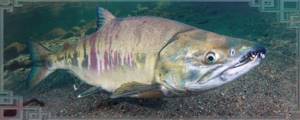
How does chum salmon differ from salmon: features and differences
Salmon and chum salmon, at first glance, are not very different from each other. Both fish can rightfully be called the queens of the salmon family. Each of them is tasty and beneficial for the human body in its own way. But, upon closer examination, there are many differences: in appearance, habitat, nutritional value and taste.
There are many legends and stories associated with salmon and chum salmon; they have a long and interesting history, accompanying royal or princely feasts from ancient times. Tender meat and nutritious caviar are still considered delicacies.
Due to irresponsible fishing, these fish, unfortunately, are now on the verge of extinction. But humanity has found a way out, and fish farms are becoming more and more popular every year.
Characteristics and brief description of the fish
A general description of red fish is given in the table.
| Class | Ray-finned |
| Squad | Salmonidae |
| Family | Salmonidae |
| Genus | Pacific salmon |
| View | Chum salmon |
| Security status | III category according to IUCN, rare species |
| The average size | 0.5 - 0.7 m, weight 4 - 6 kg |
| Lifespan | 4 – 9 years |
| What does it eat? | Crustaceans, molluscs, herring, smelt |
| What does it bite on? | Flies, nymph, spinner |
| Spawning time | August - November |
Life cycle of chum salmon
Salmon spawning occurs in the river at a temperature of +3..+5℃. Hatching of the larvae lasts 3 months. The first summer, the juveniles live in coastal areas, and then go deeper into the sea. Here she fattens up, after 3-4 years she enters the “mating season” stage and goes to her native river to spawn. In total, chum salmon travel from 2000 to 4000 km.
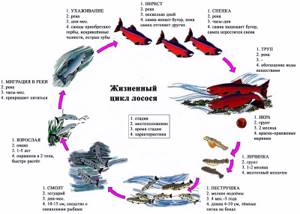
There are two subspecies of salmon based on the time they enter the rivers:
- summer - from July to September;
- autumn - from September to November.
The autumn subspecies is larger and more resilient than the summer one. The fertility of autumn chum salmon reaches 44,000 eggs, summer - 25,000.
Salmon spawn in the upper reaches of rivers with fine-pebble soil. The female lays eggs in the hole and covers it with pebbles. The dimensions of the pebble mound can reach 2.5 m in length and 2 m in width. At this time, the male protects the eggs from predators.
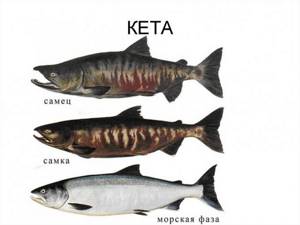
After spawning, the chum salmon female and male die in the river within 10 days, becoming food for the fry.
Photo and description of fish
The life cycle of salmon can be divided into 2 states: juveniles and mating age. At each stage, red fish changes its appearance, behavior and beneficial properties.
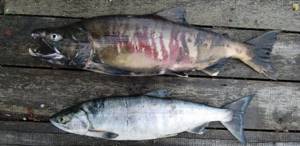
The young individual is covered with dense silvery scales, for which it received the nickname “silverfish”. The fish actively hunts, accumulates fat, gains weight of 4 - 6 kg, grows up to 70 cm. The meat of the silverfish is dense, bright red in color.
“Nuptial plumage” transforms the description of chum salmon; as can be seen in the photo, it is covered with purple spots. The scales of the “silverfish” become coarser and turn brown. The head is modified. The jaws stretch, bend, and fangs appear. Local fishermen call chum salmon “catfish.”
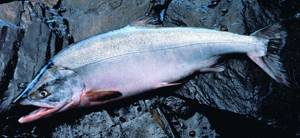
Salmon become aggressive, form schools and head for river mouths. From this period, the “catfish” stops hunting and feeds on its own fat reserves. The meat becomes lighter.
After spawning, the scales of chum salmon turn black. The internal organs of the catfish atrophy. The fish dies from exhaustion.
Habitats
The chum salmon spends part of its life in the seas and part in rivers. “Serebryanka” is found in the basins of the Arctic and in the northern latitudes of the Pacific oceans.
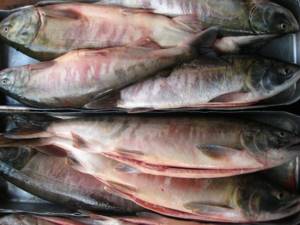
“Zubatka” enters Kolyma, Indigirka, Lena, Yana, and the Canadian Mackenzie River. Numerous spawning schools of salmon are found in the Amur and Okhota rivers, off the coast of Sakhalin, Kamchatka, and the Kuril Islands.
The benefits of chum salmon meat for the body
The nutritional value and chemical composition of red fish are given in the table.
| Nutrient | Quantity in product per 100 g | Percentage of recommended daily value, % |
| Energy value, kcal | 127 | 8,1 |
| Proteins, g | 20 | 21,2 |
| Fats, g | 5,6 | 8,1 |
| Carbohydrates, g | 0 | — |
| Water, g | 74 | 2,7 |
| B vitamins: | ||
| B1, mg | 0,33 | 22 |
| B3, mg | 8,5 | 42,5 |
| B5, mg | 1 | 20 |
| B6, mg | 0,5 | 25 |
| B12, mg | 0,004 | 137 |
| Vitamin D, mg | 0,016 | 163 |
| Vitamin E, mg | 1,3 | 22 |
| Potassium, mg | 335 | 13,4 |
| Phosphorus, mg | 200 | 25 |
| Iodine, mg | 0,05 | 33,3 |
| Fluorine, mg | 0,43 | 10,8 |
| Cholesterol, mg | 80 | 26,7 |
| Ash, g | 1,2 | — |
Chum salmon is rich in protein, fatty acids, vitamins and microelements. Silverfish meat is well digestible.
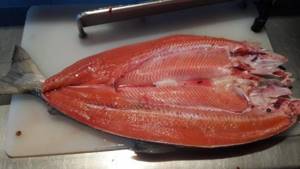
Eating 130 grams of red fish 3 times a week improves the body’s condition:
- Unsaturated fats cleanse blood vessels and lower blood pressure. The risk of heart attack and stroke is reduced.
- Vitamin B1 helps to remember better, develop attention and thinking.
- Thanks to B vitamins, immunity is strengthened and metabolic processes are normalized.
- Vitamin D prevents the development of rickets, leukemia, breast and brain cancer. Controls blood glucose levels.
- Vitamin E and omega affect wrinkles and renew the skin.
- Iodine stimulates brain activity. Increases the elasticity of the walls of blood vessels. Improves the condition of skin, hair, nails.
Salmon reduces stress in the body and improves performance. Keto meat is recommended for children, older people, pregnant and nursing mothers.
The benefits of chum caviar
Chum salmon caviar and milk are no less valuable than meat. The calorie content of caviar is 250 kcal. The eggs are large - 7 mm in diameter, orange in color. The caviar melts in your mouth and you can feel its airiness.

Salted chum salmon caviar and milk are used in cosmetology, obtaining a whitening and rejuvenating effect.
Tasty facts
Males are fatter than females: the dish they make is richer, juicier and more nutritious. Keto meat is salted, smoked, stewed or baked. In industrial production, salmon meat is canned. Due to the high water content, frying it is not recommended: the meat becomes dry.

Chum salmon fillet makes a tender and healthy fish soup with cream. Pre-meat. Suitable ingredients include coarsely chopped potatoes, carrots, and celery.
Fresh silverware can be stored in the refrigerator for no longer than a day. At -18 ℃, red fish retains nutrients for 3 months. You need to defrost the chum salmon carcass gradually, without using a microwave. Otherwise, the structure of the meat will be destroyed and the taste will deteriorate.
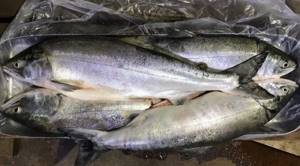
Cold smoked chum salmon can be eaten for 10 days. Hungry smoking preserves the benefits of the product for up to 3 days.
Fishing for chum salmon: features
A fisherman will need skill to catch a silverfish by trolling. In coastal waters, chum salmon swim at a depth of up to 10 m: fishing with a boat will scare it away.
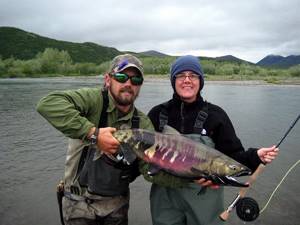
A good time for fishing is the beginning of the spawning route of the chum school to the river mouths. Closer to the spawning site, catfish lose nutrients and taste value, so such fishing is not practical. On an industrial scale, salmon are caught using nets or traps.
Fans of excitement and adrenaline catch red fish by fly fishing. Chum salmon bite quickly and sharply. The fisherman may not notice the bite while the “catfish” moves out of the reach and into the riffle, quickly unwinding 100 m of line. Fishermen use a powerful 9th or 10th class fishing rod and bait - 10 - 15 cm flies, streamers.
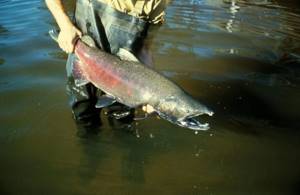
Catfish do not feed in rivers. However, she retains her protective reflexes. Local fishermen use spinners and oscillating spoons as spinning bait. Before fishing, you need to scout out the reservoir, and then select a fishing rod, test and lure. For example, long rods are chosen for fishing for large individuals, but they are not suitable for fishing from a boat or in thickets.
Similarities between salmon and chum salmon
- Pedigree. Both fish are from the salmon family. The meat and caviar of which are highly valued and considered a delicacy in all countries of the world.
- Habitat and spawning. The habitat and life cycles are similar. For most of their lives, salmon and chum salmon live in the cold, salty waters of oceans and seas. To spawn, fish go on a long journey, which ends in fresh rivers with steep rapids. Before spawning, their food consists of small fish and crustaceans. During spawning, individuals stop feeding and lose weight. They lay from 7 to 25 thousand eggs, which are highly valued for their large elastic eggs of bright orange color.
- Benefit. Chum and salmon meat is very nutritious and rich in vitamins, fatty acids, micro- and macroelements. Regular consumption of these fish, as well as their caviar, can strengthen the immune system and normalize the cardiovascular, nervous and digestive systems.
- Harm. People who are allergic to fish or seafood are strictly prohibited from eating salmon or chum salmon. There are cases when allergies manifest themselves to additives, antibiotics or feed components; this only applies to artificially raised animals.
Salmon
- A distinctive feature of salmon is its bright silver scales and darker, blue-tinged back, without spots.
- Salmon meat. The color of salmon meat is graded - from pale pink to red-orange, it depends on the components of the fish feed. Every year the number of salmon in the wild decreases. Since September 2021, it is listed in the Red Book of Russia. Modern fish farms are engaged in its artificial breeding. In Norway, for example, there are a lot of fish farms where salmon are raised. But the taste and quality of such fish is much inferior to wild representatives of this genus.
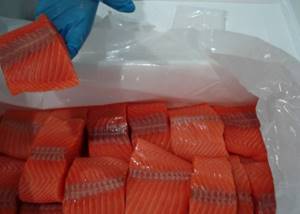
Chum salmon
- Chum salmon is a species of Pacific salmon. The catch of which breaks world records.
- The maximum length does not exceed 100 centimeters, weight - 15 kilograms.
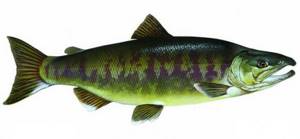
- Appearance varies depending on hydrological conditions. In ocean water it has a uniform silver color. In fresh water, its color darkens and its jaw becomes larger. Chum salmon meat is bright pink.
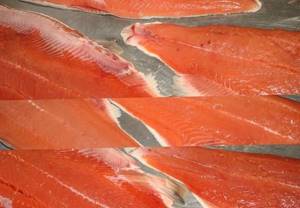
Harm and danger of fish in food
Salted and smoked chum salmon is harmful for diseases:
- kidneys and genitourinary system;
- stomach;
- hearts;
- gout
The high salt content in chum meat, caviar and milk leads to fluid retention and the appearance of edema. The product should be consumed in portions so as not to harm the body.
Farmed red fish may contain harmful metals and GMO products because they are fed artificially.

Manufacturers of canned fish use salmon “with spawning changes” when the benefits of chum meat for humans are reduced. Unscrupulous companies may pawn the remains of catfish that died after spawning.
Improper storage causes changes in the chemical composition of red fish. Thus, the amino acid histidine is converted into histamine, large doses of which cause poisoning and allergies.
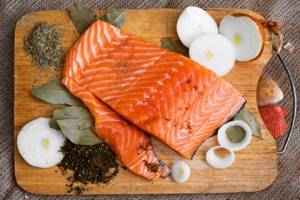
When choosing silverware in a store, you need to pay attention to storage conditions so as not to harm your health. Falling salmon scales, brown gills, and cloudy eyes are signs of a stale product. Frozen fish should be completely covered with a thin glaze to protect it from air.
Salmon and trout - what kind of fish are they?
Sometimes salmon, salmon and trout are called the same fish or it is simply difficult to identify the differences, which is not surprising due to the variability, wide distribution of species and the lack of a unified scientific classification. The names “salmon” and “trout” are essentially collective names denoting a group of species. Often local and national names do not correspond to the classification ones, which causes difficulties and leads to confusion. Thus, rainbow trout, widespread in Russia, is sometimes called Kamchatka salmon or salmon. Brook and lake trout species are called brown trout. And salmon is nothing more than salmon itself, as well as noble, northern or Atlantic salmon, as opposed to the Pacific species.
We can definitely say that both salmon and trout belong to the salmon family (and the subfamily of the same name) and are similar in a number of criteria:
- They are incoming freshwater, that is, in most cases they live in salt waters, but go to fresh waters to spawn. Due to the great demand for red varieties of fish, artificial breeding of salmon and trout has recently become popular;
- The body of both fish is covered with dark spots along the back and sides. In young individuals they are more pronounced;
- near the tail there is an adipose fin containing from 10 to 16 rays and distinguishing individuals of this family from others, in particular herrings, with which there is an external resemblance;
- The meat of salmon and trout is red with white streaks. The shade may be more saturated and bright or pale depending on the diet. Too bright a color is often a sign of the use of dyes in food through artificial breeding.
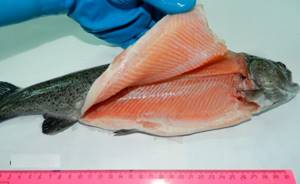
Trout and salmon meat may be pink or orange.
Types of chum salmon
Salmon are characterized by pronounced homing (return to the exact place of birth). Chum salmon always migrate to breed in the river where they spawned and try to find their native spawning ground. This genetic feature allowed ichthyologists to divide the species into two independent forms - North American and Asian, which do not overlap geographically.
The Asian taxon lives and spawns in Russia. Based on statistical samples of meristic and genetic studies, scientists were able to identify several regional subspecies of Asian chum salmon:
- Sea of Okhotsk - south and northeast of Sakhalin;
- southern - Primorye, Kunashir, Iturup;
- Amur - Amgun, Ussuri, Zeya, Bikin, the northern part of the Tatar Strait;
- Sakhalin - southwest Sakhalin;
- northern - Kamchatka, Chukotka.
To learn more:
Chinook salmon: a unique fish of the salmon family
All species forms are very similar in appearance and are divided into summer and autumn races. An exception is the Sakhalin chum salmon, which is used as a hatchery breeding object and has a unique exterior in silvery-greenish tones.
What is the difference between salmon and trout
The difference between the fish called salmon and trout in Russian spaces is not always obvious, but it exists.
External differences, or how to recognize fish in a store
Salmon is much larger than trout; in natural conditions it reaches one and a half meters in length and 40 kg in weight. The length of trout usually does not exceed 30 cm, and its weight does not exceed 4 kg. Therefore, a carcass weighing 5–7 kg cannot definitely be trout.
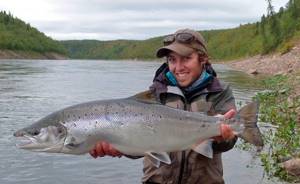
Salmon is a large fish
But you shouldn’t focus only on weight and size. Fishing begins at smaller rates. And on the store window there may well be salmon weighing up to 4 kg.
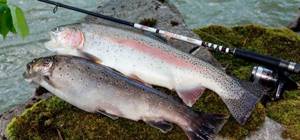
A distinctive feature of trout are bright pink stripes on the sides.
Unfortunately, it is quite difficult to recognize fish by its fillet, especially if it is sold frozen. Therefore, it is worth choosing products from proven and reliable suppliers. If doubts still remain, ask the seller to provide a certificate of quality or conformity. This way you can find out what kind of fish you are purchasing.
Fish should be purchased from reliable producers
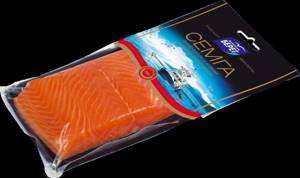
Table: main differences between trout and salmon:
| Criterion | Trout | Salmon |
| Body Shape | Wider than salmon | Streamlined and relatively narrow |
| Head shape |
|
|
| Tail shape | Square | Triangular |
| Fatty areas | Only in the abdominal area | Evenly distributed throughout the body |
| Color |
*The color of trout depends on its habitat. |
|
Maximum size of chum salmon

Some individuals can reach a meter in length and weigh sixteen kilograms. But such monsters are not often found. Typically, the size of chum salmon does not exceed fifty centimeters, and during spawning it grows to seventy.
Some residents of the Khabarovsk Territory claim that they met one and a half meter giants while fishing, but this fact has not yet been officially proven.
The average lifespan of chum salmon is about seven years.
Chum salmon in cooking
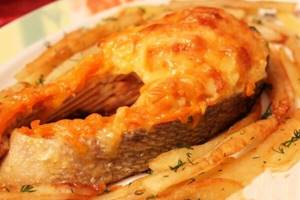
Red fish is an excellent “raw material” for creating real culinary masterpieces. This delicacy can be fried, baked, boiled, stewed, pickled and salted. Salmon can serve either as an independent dish or as a component of more complex culinary variations.
Chum salmon meat has delicious gastronomic characteristics. But it is important to cook the fish correctly. Chum salmon is one of those sea creatures whose fillet is absolutely not suitable for frying. This type of heat treatment makes the meat dry and tasteless. Therefore, if you fry fish, do so exclusively using batter. Bake in foil or in a sealed container.
In supermarkets, chum salmon is available frozen, chilled, salted or smoked. Fresh carcass is good for fish soup and other hot dishes. Salted pieces can be used to prepare salads and other cold appetizers (but this type of chum salmon usually needs to be washed to remove excess salt).
However, not only chum salmon meat is a delicacy. Its caviar has no equal among other types of red caviar - it is denser, larger, and has a beautiful bright orange color.
How to improve the taste of fish?
- Defrost chum salmon in 2 stages. The first one is in the refrigerator. The second is at room temperature. This way, the beneficial substances and correct consistency of the fillet will be preserved as much as possible.
- The scales will come off easier if, before cutting, the carcass is first poured with boiling water and then dipped in warm water and vinegar.
- It is better to bake chum salmon than to fry it. And if you fry, then only in batter (to maintain juiciness).
- Before cooking, marinate pieces of fish (or carcass) in lemon juice.
The right recipe for salted chum salmon
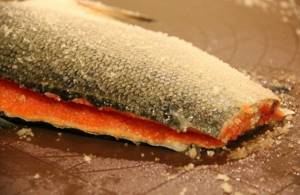
Properly salted tender pink fish meat will serve as a tasty and beautiful addition to the holiday table. This method of cooking will also help to significantly extend the shelf life of the product. And most importantly, both fresh and frozen carcasses are suitable for salting.
So, let's start cooking. The first step is to prepare the carcass: defrost, rinse, remove fins, remove the skin. Divide the fish into large pieces and prepare the mixture for pickling. To do this you will need salt and granulated sugar in equal quantities. If desired, the mixture can be “revitalized” with pepper, fish spices, coriander, bay leaf, and nutmeg. It is also permissible to add a little vegetable oil. But the main thing in this matter is not to overdo it, so that the spices do not dull the natural taste of chum salmon. Mix all ingredients thoroughly and gently roll each piece of fish in the sweet and salty “powder”. Place the fish in a pan (enamel or glass), pressing tightly. Place in the refrigerator for a day. Cooked fish is delicious as a cold appetizer or sandwich product.
Original snack
The value of this snack will be appreciated by gourmets of any age. Moreover, it cooks very quickly. All you need is lavash, salted chum salmon, processed cheese, and herbs. Place slices of salted chum salmon on lavash spread with melted cheese and sprinkle with chopped onion. Form a roll and put it in the refrigerator (to harden). Serve in slices.
Chum salmon "pearl pearl"
Pearl barley porridge is a very healthy product. But not everyone loves this cereal. It’s a different matter if it’s with delicious red fish.
Boil the barley soaked in the evening in salted water. Cut the raw chum salmon fillet into pieces and simmer in vegetable oil with the addition of water (with the lid closed). In a separate pan, simmer the onions, zucchini, carrots and tomatoes. When all the ingredients are ready, place the vegetable mixture on a plate, with a portion of chum salmon on top. As a garnish – pearl barley. To serve effectively, the porridge can be spread in a thin layer on top of the fish.
Red fish stuffed with mushrooms
Peel the chum salmon, but do not cut the belly (make a cut across the belly). Rub the carcass with the spice mixture and place in the refrigerator overnight. Prepare a mixture of salt, pepper, coriander, lemon balm, dill, lemon (zest and juice). Use mushrooms with rice as minced meat. Bake in the sleeve for about 40 minutes. Serve with steamed carrots, cauliflower, broccoli.
Red fish has earned its popularity not least due to its delicious taste. But the right delicacy is not only tasty, but also healthy. And chum salmon is a clear confirmation of this.
More fresh and relevant information about health on our Telegram channel. Subscribe: https://t.me/foodandhealthru
We will be grateful if you use the buttons:
Chemical composition
Nutritional information per one hundred gram serving:
| Calorie content | Belkov, Mr. | Zhirov, g | Water, g |
| 127 kcal | 19 | 5,5 | 74,3 |
Fresh chum salmon does not contain carbohydrates or dietary fiber, making it an excellent product for low-carbohydrate diets.
Vitamin composition per hundred grams, in mg:
| A | IN 1 | AT 2 | AT 5 | AT 6 | AT 9 | AT 12 | D | PP |
| 0,04 | 0,31 | 0,22 | 1 | 0,6 | 0,015 | 0,04 | 0,016 | 8,5 |
Macronutrient composition per hundred grams, in mg:
| K | Ca | Mg | Na | S | P | Cl |
| 336 | 21 | 33 | 61 | 191 | 212 | 163 |
Microelement composition per hundred grams, in mcg:
| Fe | I | Co | Mn | Cu | Mo | Ni | F | Cr | Zn |
| 60 | 50 | 20 | 50 | 110 | 4 | 6 | 430 | 55 | 0,7 |
In addition, chum salmon contains a number of essential amino acids: arginine, leucine, threonine, tyrosine, histidine, lysine.
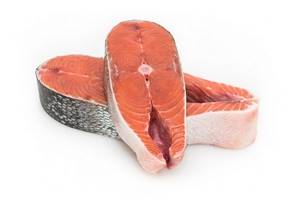
Chum salmon: numbers, status and commercial importance
Over the past 120 years, maximum numbers of Amur chum salmon have been recorded only twice. The maximum catch of summer chum salmon in 1910 was 53 thousand tons, with a total stock of 25 million individuals. The maximum number of autumn chum salmon was also noted in 1910 - 40 thousand tons with a stock of 12 million individuals.
The usual catch of autumn chum salmon in the Amur is about 15 thousand tons with a catch of 5–7 million fish. During the depression period 1970–2005. catches dropped to 1–3 thousand tons with a stock of about 0.6 million individuals. After 2010, the catch of autumn and summer chum salmon increased. In 2015, a total of 35.7 thousand tons of chum salmon were caught, and in 2021 – 42.0 thousand tons.
Commercial significance
Chum salmon is one of the main commercial fish species in the Amur River basin. Industrial fishing for Amur autumn chum salmon is concentrated not only at the mouth of the river. Amur. It begins on the northern coast of Sakhalin Island, where fixed seines and drives are exhibited. Continues in the lower reaches of the Amur, where drive-ins and flowing gill nets work. Along 1,000 km upriver, fisheries and the public catch fall chum salmon with floating and set gill nets. Above Khabarovsk, Chinese fishermen catch chum salmon.
In accordance with the Law of the Russian Federation “On Fisheries”, for the needs of the local population (Russians, Nanais, Ulchis, Nivkhs, Udeges and Negidals), the volumes of permissible catch, as well as the conditions for fishing autumn and summer chum salmon by the indigenous peoples of the Amur region, are provided.
In 2021 and 2021 An unusually weak spawning run of chum salmon in the river was noted. Amur. The spawning grounds were very poorly filled. During these years, the rules of fishing on the Amur were revised, significant changes were proposed: the size of industrial fishing gear was reduced and the rules for their placement in fishing grounds in the lower reaches of the Amur were changed. Chum salmon was even included in the Red Book of the Amur Region due to the low abundance of the species in this region.
However, over the last 2-3 years (obviously thanks to the measures taken), the number of salmon producers (pink salmon, summer chum salmon) has increased by 2-2.5 times compared to 2021. There is no data regarding the autumn chum salmon yet; they will probably be announced after the end of the great Amur season. this year's expedition.
Chum salmon 2021: preliminary results of the autumn season
R. A. Fofanov (Head of the Department of Fisheries and Fish Farming of the Ministry of Agriculture of the Khabarovsk Territory) announced the preliminary results of the autumn fishing season 2021. The autumn season began on August 25 in Nikolaevsk-on-Amur and will end in the Khabarovsk and Nanai regions on October 10. In the North Sea of Okhotsk subzone, the catch of chum salmon and pink salmon as of October 1, 2020 amounted to just over 25.5 thousand tons. By the way, this year the fishing season was more successful for the fishermen of the Nikolaev region.
| Fishing place | 2019, thousand tons | 2020 g, thousand tons |
| Nikolaevsky district | 3,2 | 5,7 |
| Ulchsky district | 2,8 | 1,05 |
| Along the Amur (for all types of fishing and for all regions) | 8 (out of 16.5 according to plan) | 7.7 (out of 13, 9 according to plan) |
In each region, the autumn season has its own characteristics and final results. By the way, both this and last year the results of the fishing season were affected by the flood. If in normal years the chum salmon moves along the riverbed, then during a flood it is dispersed throughout the water; there are areas where the water has spread (so to speak) for tens of kilometers. Fishing in such conditions is very difficult. Moreover, the flood also affects the populations of chum salmon and pink salmon, because the fish enter lakes and reservoirs instead of going to spawning rivers. This is in short, other details are in the interview with R. A. Fofanova with Morning with Gubernia (01.10.2020).
Keta and interesting things about her
Often, unscrupulous sellers try to sell good-natured buyers a similar, cheaper pink salmon instead of expensive chum salmon. In this case, you should know several distinctive signs of chum salmon so as not to fall for the bait of deceivers.
This is interesting: Recipe for salting pink salmon caviar
Firstly, chum salmon is a large fish and its weight should not be less than five kilograms. Secondly, pink salmon have a small hump, which is how it got its name. In addition, in order not to become substandard, you need to pay attention to the fact that fresh fish has pink meat, and after pressing on the carcass, it quickly takes its previous shape.
Chum salmon for a snack?!
It would be wrong to end the article without telling at least a little fishing story about this amazing Amur fish. Everyone knows that chum salmon, like all salmon, are caught in nets on the Amur. They are also caught using an elastic band (bottom shock absorber).
I managed to catch a chum salmon on a hook. This happened 5 years ago. It was a warm, sunny September day. We fished on the Shargol channel. We caught a variety of fish: crucian carp, carp, bleak, killer whale, of course, without it we couldn’t go anywhere. I fished with ordinary hooks; I’ve been fishing with throws since childhood, so I learned to cast far.
The current in this place is strong, the line to the shore was already at 60 degrees. It was necessary to pull out the tackle and I began to choose a fishing line. Far from the shore, a large fish jumped out of the water like a candle. The fishermen on the shore and I quietly exhaled with them. I wish I could catch one!
I continue to select the fishing line and realize that I have a fish on the hook. I only realized its size when I pulled it a little closer to the shore. If you could see how desperately the chum salmon resisted! She either stopped (with great difficulty I “pulled” her from her place), then went to the right, then to the left; then she finally gave in and I quite calmly pulled her ashore. The male weighed 4.5 kg. I don't think I've ever caught a bigger fish. There was an Amur catfish of 3.5 kg; black bream 2.8 kg; carp weighed 2.5 kg and there was a long whip (about 70 cm) - this one was not weighed and I regret that we did not measure it.
Chum salmon fish: nutritional value, meat composition
Chum salmon meat has a lot of beneficial properties, which are due to the significant content of beneficial microelements and vitamins in the meat. The most important of them are the following substances:
- vitamins E, C, B1, B2, A;
- iron, fluorine, zinc;
- nickel, chromium, molybdenum;
- potassium, phosphorus, chlorine;
- calcium, magnesium, sodium.
Most people doubt whether they should eat chum salmon, because it contains a significant amount of cholesterol. However, all these fears are in vain, since 100 grams of the product contains only 80 milligrams of cholesterol. This figure is not significant and has virtually no effect on the human body. In the popular fish mackerel, this indicator reaches a higher level. But nevertheless, the fish is famous for its popularity.
Price of chum salmon and caviar per 1 kg
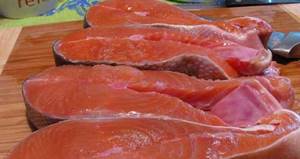
The price of chum salmon caviar directly depends on its packaging. In plastic boxes it will be much higher than in plastic bags. On average, the price per kilogram of caviar is more than 4,000 rubles. So, 200 grams of chum salmon caviar in a plastic bag will cost 900 rubles, and salted-frozen caviar in a 200 gram plastic bag will cost 810 rubles. Chum salmon itself will cost lovers of fish cuisine from 300 rubles per kilogram. The average bill in Moscow and the Moscow region is 406 rubles per 1 kg. The price for chum salmon fillet starts
General information about chum salmon
Chum salmon is a red fish that belongs to one of the species of salmon found in the Pacific Ocean. After 4 years, she can be considered a full-fledged adult. By this time, she begins to spawn.
The presented marine life is a very popular food product. In the world of fishing, it occupies one of the key roles and is second only to pink salmon.
The length of an individual can reach 1 meter and weight 14 kilograms. Very often, famous doctors and nutritionists use chum salmon in their diet. This type of fish is famous not only for its tasty low-calorie meat, but also for its expensive red caviar. On store shelves, chum salmon can be seen frozen, fresh, salted or smoked.
What does chum salmon look like?
The body of the fish, which is not yet capable of spawning, has a bright silvery tint. Chum salmon has an elongated body shape. This is a fairly large fish.
During the mating season, the sea and river inhabitants acquire a slightly different, brighter color. Purple spots form on her body. And the color of the entire individual changes to yellow-brown. At the same time, the skin of the chum salmon becomes much thicker, and the body expands in width. The fish's jaws become significantly deformed and curved teeth appear. When the fish begins to spawn, its color changes to black, and it is completely worthless.
Size, weight of the individual
Chum salmon is one of the fairly large fish. According to officially registered data, the largest individual was 1 meter long and weighed 16 kilograms. However, such giants are not always found. The average length of the fish is 50 centimeters.
When chum salmon lay eggs in winter, their length can increase to 0.7 meters. According to residents of the Khabarovsk Territory, chum salmon larger than 1.5 meters in size live in their local reservoirs. However, there are no documented facts about this yet.

Where does it live?
Chum salmon can only be found in the waters of the Pacific Ocean. Despite the fact that the fish lives exclusively in sea waters, it goes to spawn in the rivers of the Far East, North America and Asia. Also, a similar individual can be found in Alaska.
This aquatic inhabitant feeds in the Sea of Okhotsk, Bering and Japan, and stays in the water at a level of 10 meters from the surface. In spring, the fish slowly move to the river mouths. Most often chum salmon can be found in the Lena, Kolyma, Indigirka and Yana rivers.
Over time, all inhabitants are divided into two types: sexually mature fish and immature ones. Those individuals that are not yet ready to spawn return to the seas, and the rest go to spawning areas. They will never return from these places.
What does it eat?
Chum salmon is a predatory fish. She eats similar representatives of the marine world as food. The main food is smaller individuals of the same family and other marine inhabitants:
- gerbil;
- smelt;
- herring;
- crustaceans.
While in rivers, she completely refuses to eat. Juveniles prefer to feed on insects, their larvae, worms and small crustaceans. This representative of the marine world is able to find food in any conditions. The variety of food consumed by fish can make it easier for the fish to find food.
How does it reproduce
Chum salmon is a migratory fish. She prefers to spawn in rivers, while the main part of her life is spent in the sea. This process occurs only once in her life, after which she ceases to exist. Its remains are the first food for newborn fry and other small marine life. The total lifespan of fish is no more than 7 years. Sometimes it can reach full maturity at 4 years of age.
This type of individuals enters the river in flocks. They move to places where they themselves were once born. The fish that rise up the river have a number of distinctive features from those that live in the sea. The main visible sign is the black color. In this state, chum salmon is considered unfit for food. It can only be used as dog food.
Commercial fishing
Among all salmon species, industrial fishing for chum salmon is carried out on the largest scale. Marine inhabitants of this species are caught from the seas using fixed or floating nets. Very often, fish can be intercepted during their passage through river mouths. Often, in places where this fish is caught, temporary processing stations are erected. This measure helps avoid spoilage of the catch. These small factories are temporary structures, of a seasonal type.

At the end of the seasonal fishing, the production of primary fish processing is curtailed. This measure allows you to keep a larger amount of the product in a salable condition.


